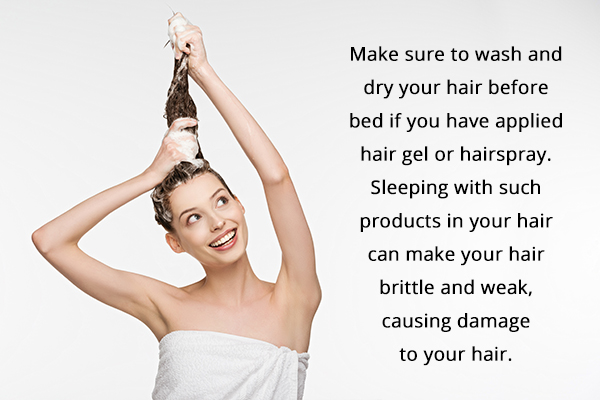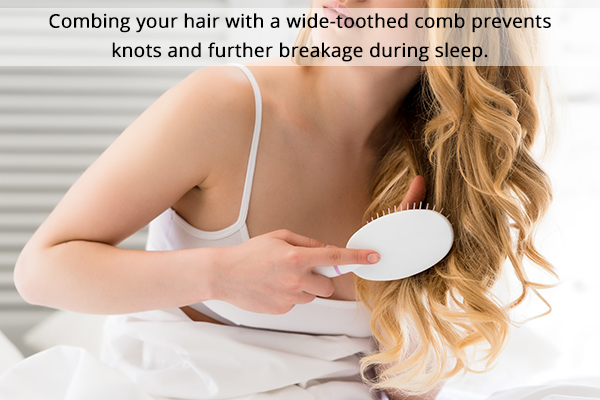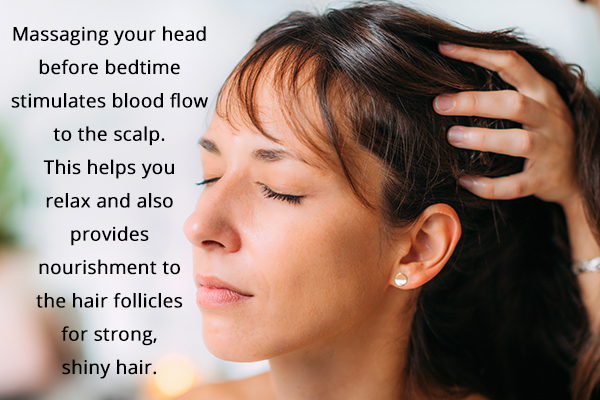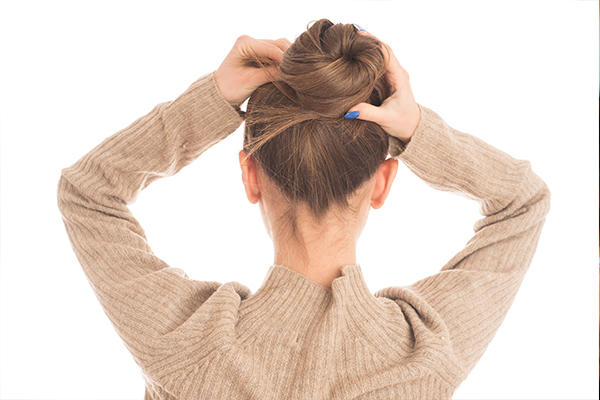In this article:
Hair care is an important part of every woman’s routine, and most women suffer from frizzy and unmanageable hair in the morning, whether they have silky straight hair or playful curls.

This article presents a list of ways to protect your hair from damage while you sleep and have beautiful hair when you wake up.
Tips to Protect Your Hair at Night
Here are a few tips to protect your hair at night:
1. Use an 8-hour protective serum
Hair serums help to repair the hair shaft, hydrate your hair, and reduce frizz. Apply a few drops of any hair serum before bedtime to allow it to penetrate deep into your scalp and rejuvenate the hair follicles. (1)
2. Try hair growth peptide sprays on the scalp
Apply a few drops of copper peptide spray to your scalp and hair before bedtime. Copper peptides reduce hair fall and promote new hair growth, thus significantly increasing hair growth and thickness. (2)
3. Avoid overnight oils
Do not leave oil in your hair for more than 4 hours as that is the maximum time it takes for your scalp to absorb all the nutrients in it.
4. Wash off hair styling products

Make sure to wash and dry your hair before bed if you have applied hair gel or hairspray. Sleeping with such products in your hair can make your hair brittle and weak, causing damage to your hair. (3)
5. Avoid pins and clips during bed
Avoid wearing any tight clips or pins on your hair while sleeping. This puts extra pressure on your hair strands and may lead to hair fall and hair breakage.
6. Use overnight hair sprays
Overnight hair sprays contain hair oils that are absorbed by the scalp and help nourish your hair follicles. Use an overnight hair spray before bed to keep your hair soft, shiny, and strong.
7. Dry your hair before bed
Never go to bed with wet hair as this can lead to hair damage. Wet hair is more fragile than dry hair and tends to break easily. Split ends are also more likely to occur when you sleep with wet hair.
8. Use the right brush or comb for your hair type

Combing your hair prevents knots and further breakage during sleep. Use a wide-toothed comb or gentle brush and lightly run it through your hair from the roots to the tips. (4)
9. Wear a nightcap or silk scarf
A nightcap or silk scarf is a great investment for your hair. It helps keep your hair in place all night, no matter how much you toss and turn. This helps prevent tangles and frizz in the morning.
10. Splurge on a silk pillowcase
Cotton or polyester pillowcases can be rough on your hair. Satin or silk pillowcases provide a soft and friction-less base to your hair that reduces frizz and hair damage. (5)
11. Massage your head before bed

Massaging your head before bedtime stimulates blood flow to the scalp. This helps you relax and also provides nourishment to the hair follicles for strong, shiny hair. (6)
Hairstyles for the Nighttime
The way you style your hair at night can help keep them frizz-free and soft. Here are some bed-friendly hairstyles you can try:

- Plait – A loose plait helps keep your hair in place all night and prevents split ends. Just brush your hair lightly in the morning for ready-to-go waves.
- Ponytail – Use a scrunchie to tie a low ponytail before bedtime. This helps prevent hair tugging and frizz in the morning.
- Small loop – If you suffer from split ends, you can turn your loose ponytail into a loop by tying the loose end of your hair up into the scrunchie. This creates a small loop that protects your hair ends.
- Bun – A loose and low bun may be the best hairstyle to wear at bedtime. Secure the bun in place with a scrunchie and you are good to go.
Do’s and Don’ts
Several products or accessories can be used to secure your hair in place. However, not all of them are good for you.
Here is a brief list of the items you should or shouldn’t use on your hair:
Don’t use:
- Rubber bands
- Thin bands
- Metal hooks
- Tight hair clips
Use:
- Soft hair bands
- Velvet/satin bands
- Scrunchies
- Handmade accessories such as sock pullers, tights, a piece of cotton, and silk/satin bands.
Most-Asked Questions
What is a bed head?

“Bed head” is a term widely used to describe the unruly and messy hair you wake up with. Tossing and turning at night lead to tangles and hair damage that may make your hair particularly difficult to manage in the mornings.
Are satin sleep caps good for the hair?
Satin caps provide a soft covering for your hair and help reduce friction between your pillowcase and hair. This prevents knots and tangles in your hair and also helps reduce frizz. Satin caps are also known to prevent split ends.
Final Word
Your hair is an important aspect of your appearance and should be cared for accordingly – even while you sleep. Adopting the measures given above in your nighttime routine will leave you with healthy and well-maintained hair in the morning.
- Was this article helpful?
- YES, THANKS!NOT REALLY


